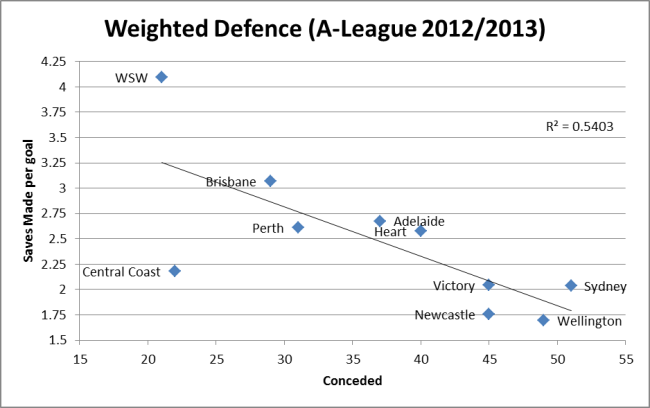In a fairly good indication that the off-season is going to be way to long, I’ve started delving into the statistics of the A-League, given there is a dearth of good statistics available for the league, I’ve been forced to craft some of my own, here’s my first attempt, I’ve called it Weighted Defence. 
This graph basically illustrates the importance of each save a keeper makes, relative to the goals he concedes, it can also help us delaminate between teams which have good defences and those which have good goalkeepers. The two standout defensive teams for the year, Central Coast and WSW both had very good statistics, the reason for these are entirely different, as is clear here. Central Coast relied on a solid defensive pairing, which meant the goals conceded was still low, but the saves made per game was quite low, relative to most of the competition (which had an average of roughly 2.5 saves per goal) it also exemplifies just how important Ante Covic was to the Wanderers this year, he made nearly double the amount of saves that Matt Ryan made on an average basis, which dulls some of the lustre of the defensive pairing of Beuchamp and Topor Stanley, who were widely lauded this year, if Covic had been making saves at an A-Leauge average rate, then they would have conceded an extra 10 goals during the season and while these statistics don’t allow to fully grasp the amount of saves a goal keeper has to make (Our very own Melbourne Heart shot-stoppers were forced into 103 saves this year, 1 short of the season high provided by Sydney, but this isn’t represented on the graph), reading the graph left to right gives a good indication of the strengths of an individual team. WSW benefited from having a keeper in absolutely stellar form in the shape of Ante Covic, Central Coast had one of the most organised defences in the league, Brisbane, Perth and Adelaide all had above average keepers, there defences were important in keeping the shot numbers down. While this doesn’t give a complete picture of the function of a Defensive Scheme (attacking thrusts, ball playing ability, etc) it gives an insight into the role that each component of the system (Goalkeeper, versus Defensive Unit) has on the overall success of the team’s purely defensive efforts (which is primarily what they’re there for, right?).
From a Melbourne Heart standpoint, we can glean what we already know, that our defence wasn’t our primary concern this year, the total number of saves made by our Keepers was. This is obviously a function of the defensive unit, rather than the Goalkeepers, who performed admirably throughout most of the year. Next I’ll look at a specific breakdown for Melbourne Heart’s season, rather than a league wide approach.